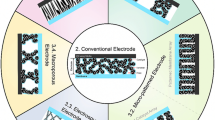Abstract
Design calculations are presented for a single-pass high-conversion electrochemical reactor suitable for process intensification in electroorganic synthesis. The key feature of the design is the use of a segmented working electrode, combined with a small anode—cathode gap. Each working electrode segment is operated at an optimal local current density, defined with respect to the local diffusion—limited current density of the reacting species. Two reactor configurations are considered:(i) an adiabatic reactor, and (ii) an isothermal reactor with integrated heat exchange. Calculated results for the devices in a classical electroorganic synthesis system, the methoxylation of 4-methoxy-toluene, are presented and the general features and performance characteristics of the cell are compared with those of a more conventional capillary-gap cell, currently used industrially. For an electrode gap of 0.1 mm, the average current density attainable in the novel design is of the order of 2700 A m−2 in the adiabatic reactor and of the order of 7100 A m−2 in the isothermal reactor, respectively, 5 and 14 times higher than the current densities applied in the current industrial process. In addition to process intensification, other advantages of the proposed technology are the absence of reactant recycle, short residence times and plug flow of the reagents, all of which contribute to improved process selectivity.
Similar content being viewed by others
References
W. Ehrfeld, V. Hessel and H. Löwe, ‘Microreactors-New Technology for Modern Chemistry’ (Wiley-VCH Verlag, Weinheim, 2000).
M. Matlosz and J.M. Commenge, Chimia 56 (2002) 654.
H. Lund and O. Hammerich, ‘Organic Electrochemistry’ (Marcel Dekker, New York, 4th (rev.) edn (2001).
R.E. Noftle and D. Pletcher, J. Electroanal. Chem. 227 (1987) 227.
C. Belmont and H.H. Girault, J. Appl. Electrochem. 24 (1994) 475.
C. Belmont and H.H. Girault, J. Appl. Electrochem. 24 (1994) 719.
A. Ziogas, H. Löwe, M. Küpper and W. Ehrfeld, in W. Ehrfeld (Ed), Third International Conference on ‘Microreaction Technology’, Proceedings of IMRET 3 (Springer, Berlin, 2000), p. 136.
M. Matlosz, J. Electrochem. Soc. 142 (1995) 1915.
C. Vallières and M. Matlosz, J. Electrochem. Soc. 146 (1999) 2933.
T. Bechthold, E. Burtscher, A. Turcanu and O. Bobleter, J. Appl. Electrochem. 27 (1996) 1021.
T. Bechthold and A. Turcanu, J. Electrochem. Soc. 149 (2002) D7.
H. Wendt and S. Bitterlich, Electrochim. Acta 37 (1992) 1951.
H. Wendt, S. Bitterlich, E. Lodowicks and Z. Liu, Electrochim. Acta 37 (1992) 1959.
‘Ullmann's Encyclopedia of Industrial Chemistry’, Vol. B1 (VCH, Weinheim, 5th (rev.) edn 1990), p. 6.
D.J. Pickett, ‘Electrochemical Reactor Design’ (Elsevier Scientific, Oxford, 2nd edn 1979), Chapter 4.
J.S. Newman, ‘Electrochemical Systems’ (Prentice Hall, Englewood Cliffs, NJ, 2nd edn 1991), Chapter 13.
Author information
Authors and Affiliations
Corresponding author
Rights and permissions
About this article
Cite this article
Rode, S., Altmeyer, S. & Matlosz, M. Segmented thin-gap flow cells for process intensification in electrosynthesis. Journal of Applied Electrochemistry 34, 671–680 (2004). https://doi.org/10.1023/B:JACH.0000031104.71463.03
Issue Date:
DOI: https://doi.org/10.1023/B:JACH.0000031104.71463.03




